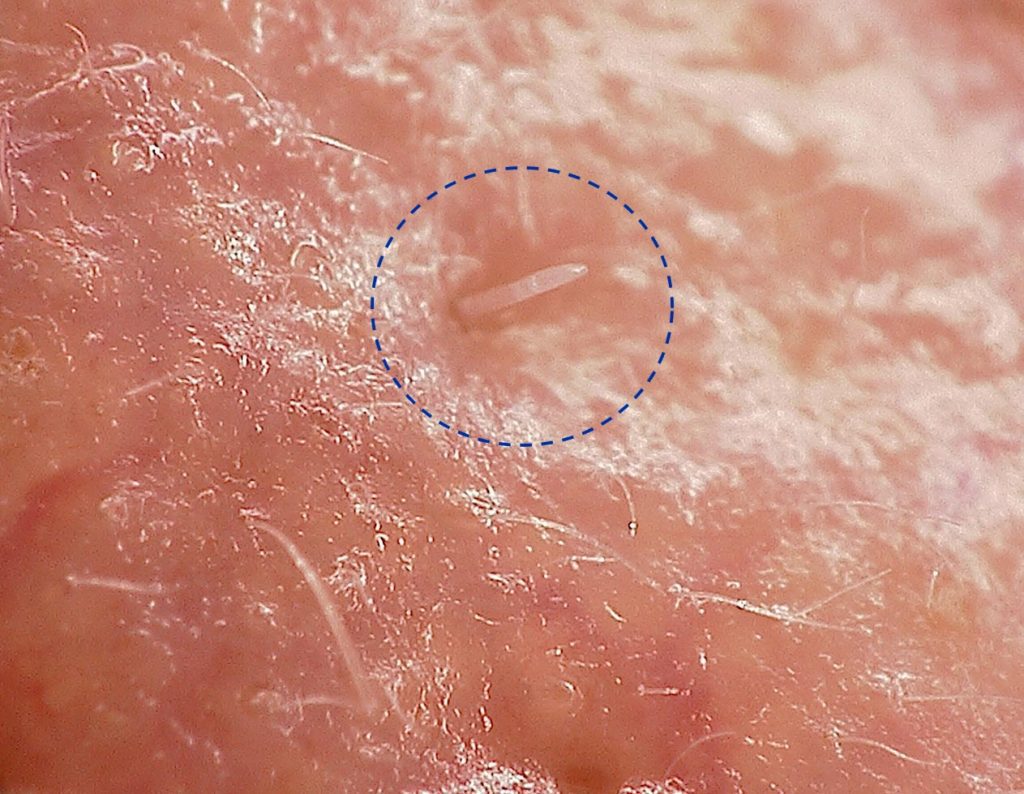
سر حياة العث في جلد وجوهنا.
أول ممتلئ على الإطلاق[{” attribute=””>DNA analysis of mites that live in the hair follicles of all humans reveals explanations for their bizarre mating habits, body features and evolutionary future.
Microscopic mites that live in human pores and mate on our faces at night are becoming such simplified organisms due to their unusual lifestyles that they may soon become one with humans, new research has found.

Image shows the unusually-positioned penis of a Demodex folliculorum mite. Credit: University of Reading
The mites are passed on during birth and are carried by almost every human, with numbers peaking in adults as the pores grow bigger. They measure around 0.3mm long, are found in the hair follicles on the face and nipples, including the eyelashes, and eat the sebum naturally released by cells in the pores. They become active at night and move between follicles looking to mate.
The first ever genome sequencing study of the D. folliculorum mite found that their isolated existence and resulting inbreeding is causing them to shed unnecessary genes and cells and move towards a transition from external parasites to internal symbionts.

Microscope image of the posterior end of the anus of a Demodex folliculorum mite. The presence of an anus on this mite had been wrongly overlooked by some previously, but this study confirmed its presence. Credit: University of Reading
Dr. Alejandra Perotti, Associate Professor in Invertebrate Biology at the University of Reading, who co-led the research, said: “We found these mites have a different arrangement of body part genes to other similar species due to them adapting to a sheltered life inside pores. These changes to their DNA have resulted in some unusual body features and behaviors.”
The in-depth study of the Demodex folliculorum DNA revealed:
- Due to their isolated existence, with no exposure to external threats, no competition to infest hosts, and no encounters with other mites with different genes, genetic reduction has caused them to become extremely simple organisms with tiny legs powered by just 3 single cell muscles. They survive with the minimum repertoire of proteins – the lowest number ever seen in this and related species.
- This gene reduction is the reason for their nocturnal behavior too. The mites lack UV protection and have lost the gene that causes animals to be awakened by daylight. They have also been left unable to produce melatonin – a compound that makes small invertebrates active at night – however, they are able to fuel their all-night mating sessions using the melatonin secreted by human skin at dusk.
- Their unique gene arrangement also results in the mites’ unusual mating habits. Their reproductive organs have moved anteriorly, and males have a penis that protrudes upwards from the front of their body meaning they have to position themselves underneath the female when mating, and copulate as they both cling onto the human hair.
- One of their genes has inverted, giving them a particular arrangement of mouth appendages extra protruding for gathering food. This aids their survival at a young age.
- The mites have many more cells at a young age compared to their adult stage. This counters the previous assumption that parasitic animals reduce their cell numbers early in development. The researchers argue this is the first step toward the mites becoming symbionts.
- The lack of exposure to potential mates that could add new genes to their offspring may have set the mites on course for an evolutionary dead end, and potential extinction. This has been observed in bacteria living inside cells before, but never in an animal.
- Some researchers had assumed the mites do not have an anus and therefore must accumulate all their feces through their lifetimes before releasing it when they die, causing skin inflammation. The new study, however, confirmed they do have anuses and so have been unfairly blamed for many skin conditions.
https://www.youtube.com/watch؟v=TriXLotwfyw
سوس الديموديكس الجريبي تحت المجهر يمشي. الائتمان: جامعة ريدينغ
قاد البحث جامعة بانجور وجامعة ريدينج ، بالتعاون مع جامعة فالنسيا وجامعة فيينا وجامعة سان خوان الوطنية. تم نشره في المجلة علم الأحياء الجزيئي والتطور.
قال الدكتور هينك برايج ، المؤلف الرئيسي المشارك من جامعة بانجور والجامعة الوطنية في سان خوان: “تم إلقاء اللوم على العث في الكثير من الأشياء. قد يشير الارتباط الطويل مع البشر إلى أنه يمكن أن يكون لهم أيضًا أدوار مفيدة بسيطة ولكنها مهمة ، على سبيل المثال ، في الحفاظ على مسام وجهنا غير متصلة. “
المرجع: “العث الجريبي البشري: الطفيليات الخارجية تصبح متعايشين” بقلم جيلبرت سميث ، وأليخاندرو مانزانو مارين ، وماريانا رييس برييتو ، وكاتيا صوفيا ريبيرو أنتونز ، وفيكتوريا أشوورث ، وعوبيد نانجول جوسيل ، وعبد الحليم عبد الصمد أ.جان ، وأندريس مويا ، وأمبارو لاتوري ، إم. أليخاندرا بيروتي وهينك آر برايج ، 21 يونيو 2022 ، علم الأحياء الجزيئي والتطور.
DOI: 10.1093 / molbev / msac125

“متعطش للطعام. طالب. متحمس محترف للزومبي. مبشر شغوف بالإنترنت.”






More Stories
صاروخ فالكون 9 التابع لشركة سبيس إكس يتوقف قبل إطلاقه ملياردير في مهمة خاصة
بقرة بحرية ما قبل التاريخ أكلها تمساح وسمكة قرش، بحسب حفريات
إدارة الطيران الفيدرالية تطلب التحقيق في فشل هبوط صاروخ فالكون 9 التابع لشركة سبيس إكس